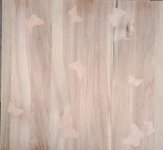As has been stated by several others, I realize that this all is a huge disappointment, and the fact that we have all been there to some degree, doesn't really make it any better.
There has been a lot of good advice here. Some of these solutions depend, at least to some degree, on your client. The "patch" method, whether you are trying to make it blend in, or as an accent, is going to be far better than filler. In my experience, unless you are going for the accent look(like a butterfly) don't make your patch too small. Many times you can cut out a larger section and make it less noticeable.
I wouldn't hesitate one second to replace that collet. They do wear out (or sustain damage) and that is why they are easily available as a replacement part, at least from the major manufacturers. A 35 year old one, on the other hand, likely not, unless it's something like Porter-Cable. Even at that, maybe not because P-C is nothing but a shell of its former self.
Personally, I favor larger shanks anyway. I prefer 1/2" for most applications, but that does add considerably to the cost. As a Festool user in the US, I have gotten into 8mm shanks in recent years. They strike a nice balance between stiffer shanks and cost, especially since they are getting easier to find.
This has gone beyond the scope of the original problem though.....sorry.
You never really can tell about wood though. A few weeks ago, I built a large room divider/screen unit out of Maple. The boards themselves were 2" x 4" (literally, not like nominal dimensions of construction lumber) and about 9' in length. They form a partiton that looks similar to vertical blinds. The timber came from a local supplier in finished size, except for length. They sat in the shop for a few weeks before I got to them, but they were all pretty straight. This doesn't have to be as perfect as a table top, since there is a 4" gap between the boards. All that to say, that one of them went crazy when I cut it to length. I was only taking off a foot or so, it's not like I cut them in the middle. Apparently there was a bundle of fibers in there somewhere that was under tension and keeping it straight, until I cut it. It bowed in both directions, becoming useless as a whole stick. It happens.
Either way, don't give up. Call it a learning experience and move on. If you are going to start getting into bigger projects like this though, a few more tools might be in order.

